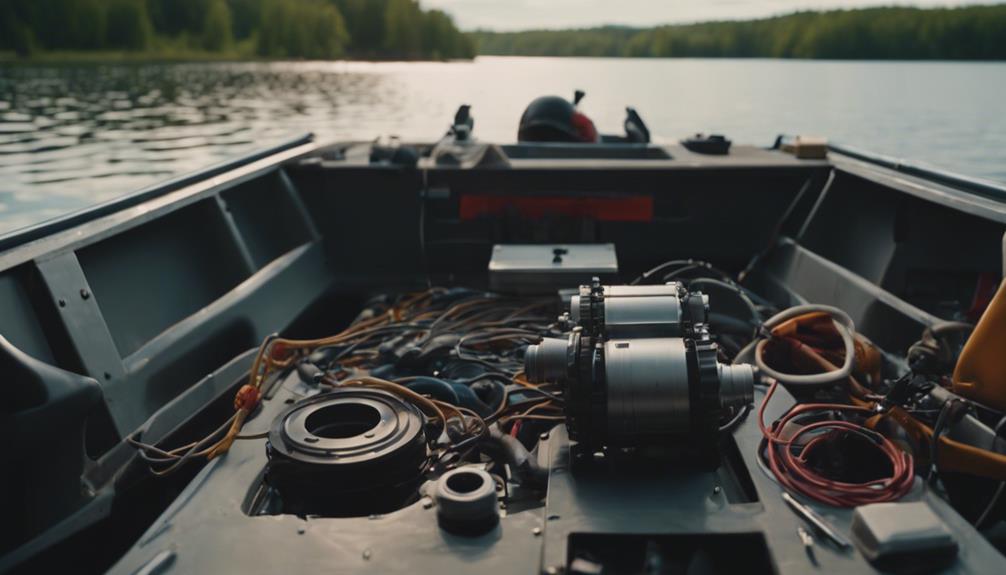If your jet boat won't start, first check if the gearshift's in neutral and the safety lanyard's attached. Verify the battery's voltage is at least 12.6 volts and inspect all connections for corrosion. Confirm there's fuel in the tank, and that all valves and vents are open. Look for kinks in the fuel lines and check the fuel filter for blockages. Finally, examine the ignition components, including spark plugs and the ignition coil. Addressing these basics can often solve the problem, and you'll uncover more essential tips to get your boat running smoothly.
Key Takeaways
- Ensure the gearshift is in neutral and the safety lanyard is securely connected before attempting to start the engine.
- Check the battery voltage; it should be around 12.6 volts, and inspect connections for corrosion.
- Verify there is adequate fuel in the tank and that all valves and vents are open to ensure proper flow.
- Inspect the ignition system, including spark plugs and ignition coils, for damage or wear that may affect starting.
Initial Troubleshooting Steps
Before diving into repairs, ask yourself: have you checked the basics to guarantee your jet boat's ignition system is ready to go?
Start by verifying the gearshift is in the neutral position, as this is crucial for the ignition system to engage. Next, confirm that the safety lanyard is securely connected and that the ignition switch is turned on.
One important step is checking the battery voltage with a voltmeter. A healthy battery should read around 12.6 volts; anything lower may indicate insufficient power to start the engine.
Don't forget to inspect all electrical connections for corrosion or damage, especially at the terminals, because poor connections can prevent the engine from starting.
While you're at it, confirm that you've got fuel in the tank. Even though we won't dive deep into the fuel system quite yet, it's essential to verify that all valves and vents are open and unobstructed.
Fuel System Checks
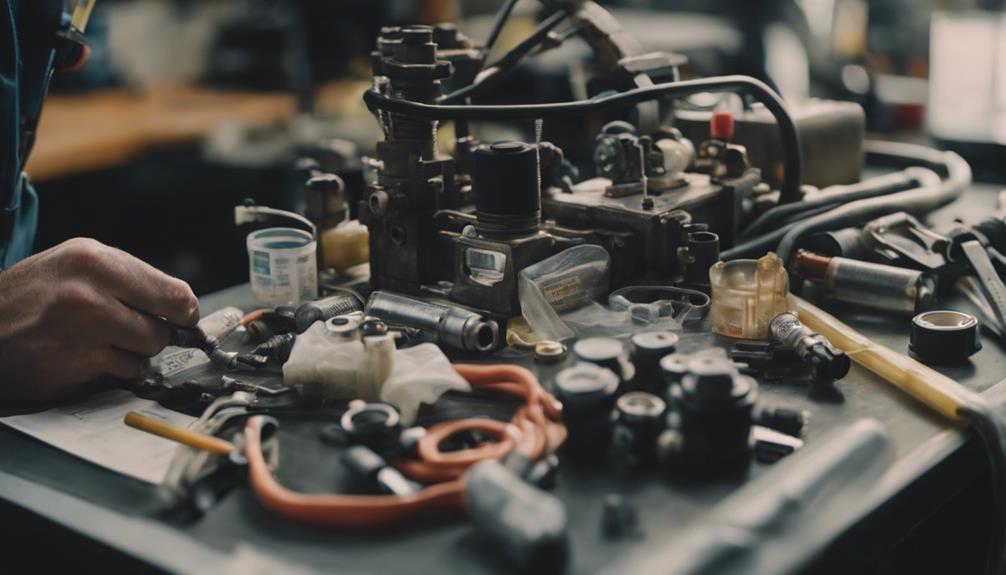
To get your jet boat started, it's crucial to check the fuel system for any issues that could be preventing proper fuel flow to the engine.
First, make sure you have adequate fuel in the tank; a low or empty tank is a common cause of starting problems. Next, inspect the fuel lines for kinks or blockages that might impede flow. Any obstructions here can stop the engine from starting.
Don't forget to check the fuel filter. If it's clogged with dirt, replacing it can greatly improve fuel delivery and get your engine running again. Additionally, verify that your gas tank air vents are open and unobstructed, as closed vents can create pressure issues that hinder fuel flow.
Lastly, confirm that the fuel solenoid is functioning correctly. It should remain open during operation—if it malfunctions, it can disrupt the entire fuel supply to the engine.
Electrical System Evaluation
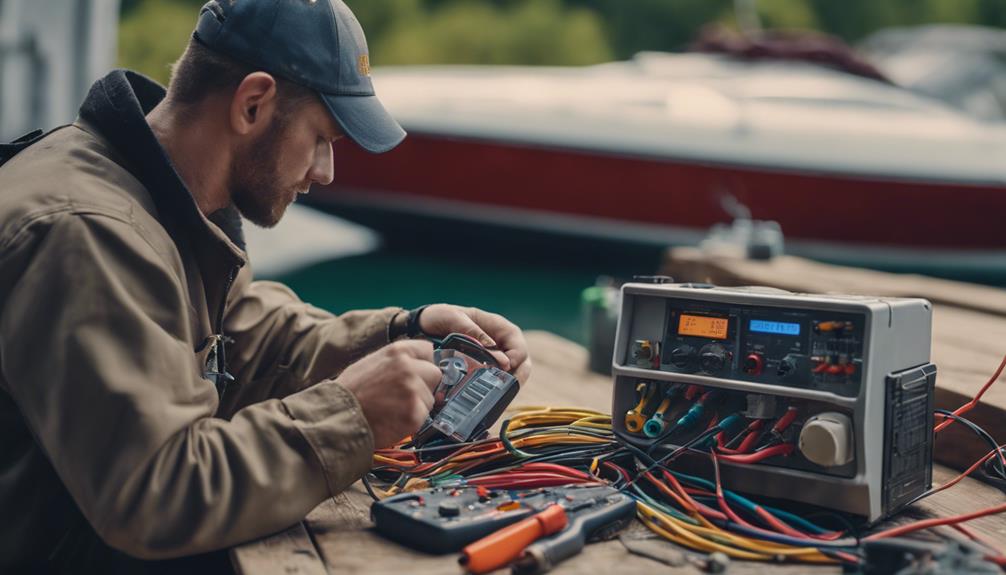
Checking the electrical system is essential for diagnosing why your jet boat won't start, as issues in this area can greatly affect engine performance. Start by examining the battery connections; verify they're tight and free of corrosion. Poor connections can impede electrical flow to the ignition system. Next, confirm that the battery switch is set to 'on' or 'both' for proper power distribution.
Use a multimeter to test the voltage at the starter solenoid. If the readings are below 12 volts, you might have battery or starter issues. Additionally, inspect fuses in the engine compartment and helm for blown ignition fuses, which can prevent the electrical system from functioning correctly. Finally, evaluate the wiring for any damage, frayed insulation, or shorts that could disrupt the electrical current needed for starting the engine.
| Step | Action Required |
|---|---|
| Check Battery Connections | Verify they're tight and corrosion-free |
| Verify Battery Switch | Set to 'on' or 'both' |
| Test Starter Solenoid | Use a multimeter for voltage readings |
Ignition System Inspection
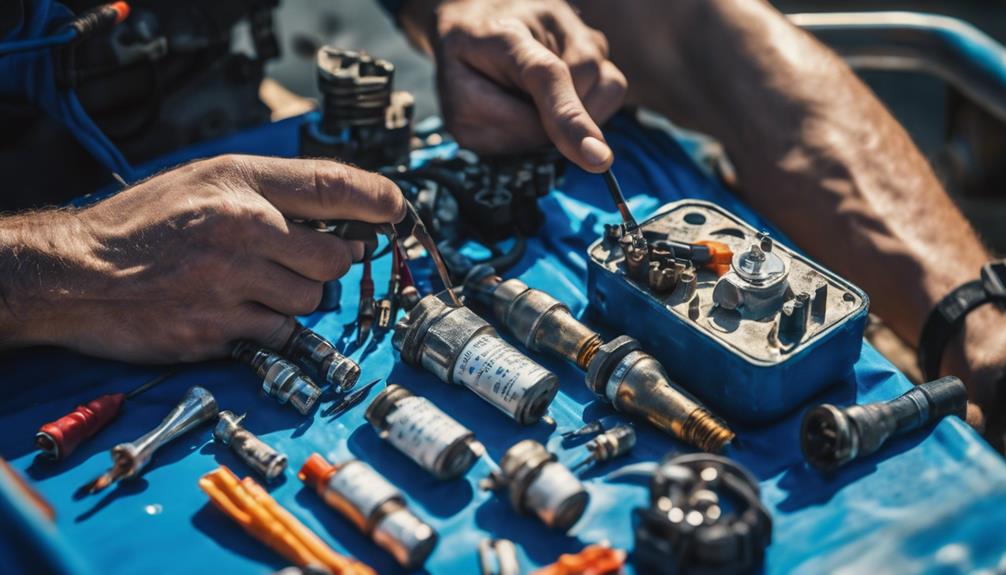
When your jet boat won't start, the ignition system could be the culprit.
Start by inspecting the ignition points to make sure they're clean and properly gapped.
Next, check the ignition coil and evaluate the distributor components for any signs of wear or damage.
Inspect Ignition Points
Inspecting ignition points is essential, as properly gapped and clean points guarantee a strong spark for reliable engine starting and performance. Regularly checking these components helps you identify wear or damage before they cause issues that could prevent your engine from starting.
| Inspection Aspect | Importance | Recommended Action |
|---|---|---|
| Gap Measurement | Secures ideal spark | Adjust according to specs |
| Cleanliness | Prevents misfires | Clean or replace as needed |
| Wear and Damage Check | Maintains performance | Replace damaged points |
| Timing Adjustment | Enhances ignition | Follow manufacturer guidelines |
If your ignition points are damaged, it's best to seek professional repair or replacement to restore proper engine function. Neglecting to maintain these points can lead to misfires, impacting your jet boat's overall reliability. Additionally, keep in mind that the efficiency of your spark plugs directly relates to the condition of the ignition points. By staying on top of this inspection, you'll guarantee that your jet boat runs smoothly and reliably, helping you enjoy those water adventures without worry.
Check Ignition Coil
A faulty ignition coil can prevent your jet boat from starting, making it essential to confirm this component is in good working condition. The ignition coil plays an important role by transforming low battery voltage into the high voltage needed to create a spark at the spark plugs. If it's weak or damaged, you might experience starting issues where the engine cranks but won't start.
To verify your ignition coil is functioning properly, you'll want to:
- Inspect for physical damage, such as cracks or corrosion.
- Test the output with a multimeter to validate it's generating sufficient voltage.
Addressing ignition coil issues early can help prevent frustrating starting issues down the line. If you find that your ignition coil is faulty, replacing it is often a straightforward repair that can greatly enhance your engine's reliability.
Don't overlook this essential component—keeping it in top shape is key to confirming your jet boat starts smoothly every time you're ready to hit the water!
Evaluate Distributor Components
Regularly evaluating your distributor components is essential for guaranteeing your jet boat starts reliably and runs smoothly. Neglecting this inspection could leave you with an engine that still won't start when you need it most. Start by checking the distributor cap for cracks or corrosion, as these can disrupt voltage delivery to your spark plugs. Next, inspect the rotor for any damage, since it directs the electrical current to the correct cylinder.
Make sure the ignition points inside the distributor are clean and properly gapped to avoid ignition performance issues. Also, verify that the ignition coil is functioning correctly; a weak or damaged coil can lead to insufficient spark. Finally, inspect all wiring connections for corrosion or wear, as faulty connections can cause significant starting problems.
Here's a quick checklist to help you:
| Component | Inspection Tips |
|---|---|
| Distributor Cap | Look for cracks and corrosion |
| Rotor | Check for damage or wear |
| Ignition Points | Guarantee proper gapping and cleanliness |
If you're unsure about any of these components, don't hesitate to consult a boat mechanic for assistance.
Mechanical Components Review
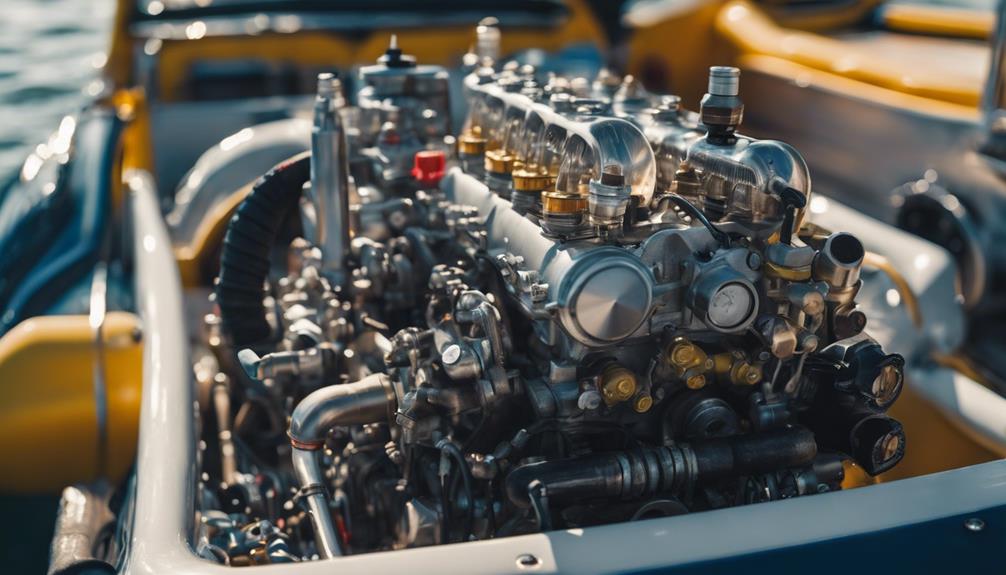
When troubleshooting a jet boat that won't start, it's crucial to review the mechanical components, including spark plugs, ignition coils, and the fuel pump. If the engine cranks but doesn't start, these components might be the culprits.
First, inspect the spark plugs for any dirt, damage, or improper gapping. These issues can critically affect combustion and prevent the engine from starting.
Next, confirm the ignition coil is functioning correctly; a weak or damaged coil won't provide the necessary spark for ignition.
Finally, verify that the fuel pump is operational and consistently delivering fuel to the engine. An ineffective fuel pump can severely hinder your starting efforts.
To summarize, pay attention to these key components:
- Spark Plugs: Check for dirt, damage, or improper gaps.
- Ignition Coil: Confirm it's working correctly for a strong spark.
Hydro-lock and Maintenance Issues
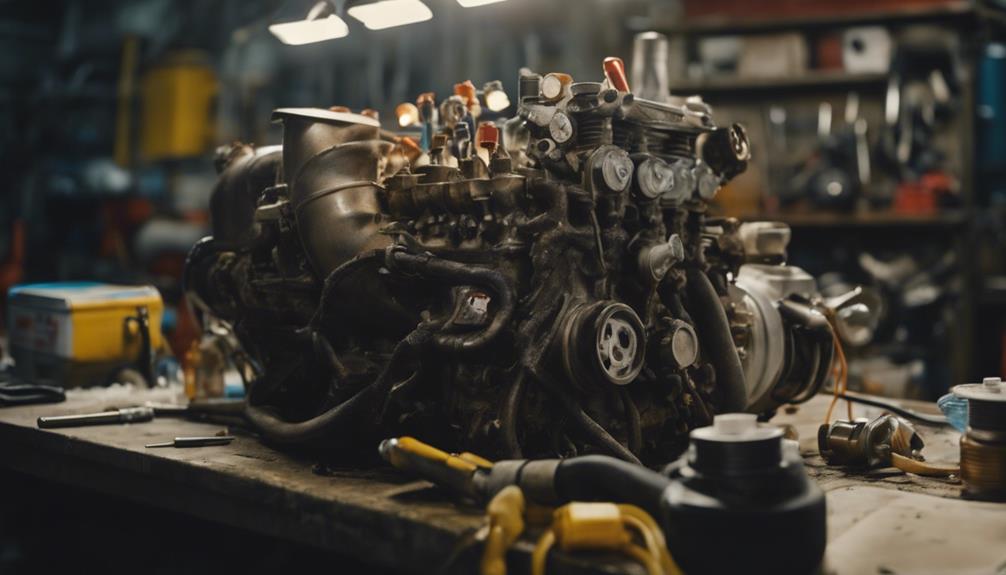
Hydro-lock can prevent your jet boat's engine from cranking, often resulting from water filling the engine cylinders due to maintenance oversights or excessive cranking. It's important to understand how hydro-lock occurs and how to prevent it to keep your jet boat running smoothly.
| Cause of Hydro-lock | Signs of Hydro-lock | Maintenance Tips |
|---|---|---|
| Water in engine cylinders | Engine won't crank | Regularly check exhaust system |
| Excessive cranking | Unusual sounds during start | Inspect seawater pumps |
| Blockages in exhaust system | Engine misfires | Monitor seawater supply |
| Wave action causing entry | Engine shuts off | Schedule routine maintenance |
To avoid hydro-lock, make it a habit to regularly check for blockages in the exhaust system and verify your seawater pumps are functioning correctly. If you notice any signs of hydro-lock, stop cranking immediately—this can prevent further damage. In such cases, reaching out to a professional is vital to safely remove the water from your engine. Proper maintenance will help keep your jet boat in prime condition and reduce the risk of hydro-lock.
Engine Longevity Tips
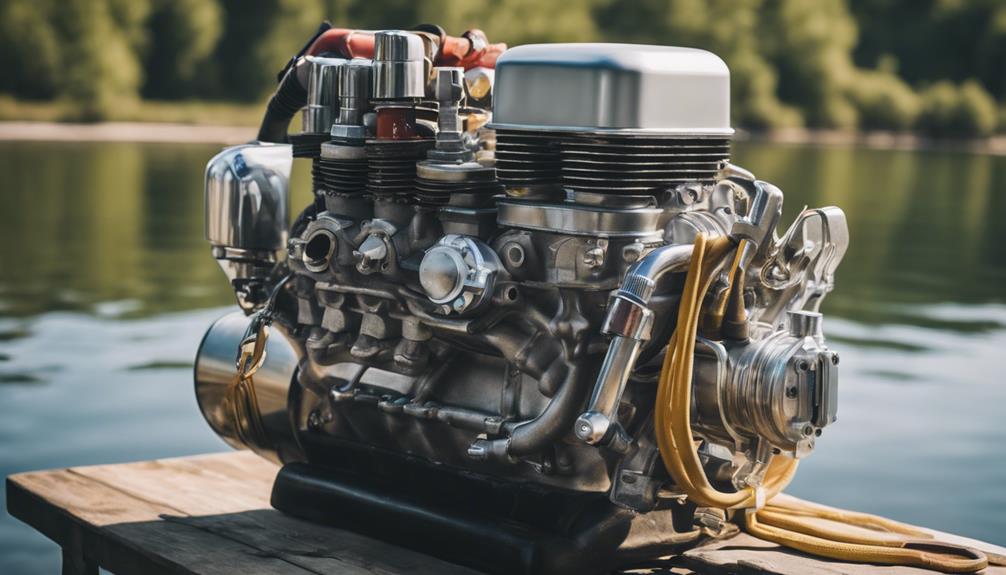
To keep your jet boat engine running smoothly for years, regular maintenance is key.
You'll want to use high-quality fuel and monitor your engine's temperature to catch any issues early.
Regular Maintenance Importance
Regular maintenance is vital for guaranteeing your jet boat's engine runs smoothly and lasts longer. By prioritizing routine care, you not only enhance performance but also greatly extend the engine's lifespan.
Here are a few key practices to keep in mind:
- Schedule regular oil changes to reduce wear and prevent overheating issues.
- Conduct inspections of components like the ignition system and fuel filters to catch potential problems early.
These steps will help you prevent an engine breakdown and avoid costly repairs in the future.
Seasonal maintenance, especially after winterization, is essential to ascertain all systems are functional. By taking the time to inspect and service your jet boat, you're investing in its reliability and safety.
Remember, a well-maintained engine not only performs better but also provides peace of mind on the water.
Fuel Quality Impact
Fuel quality plays an essential role in your jet boat's engine performance and longevity. Low-quality or contaminated fuel can lead to poor combustion and decreased power output, which you definitely want to avoid. Always use the fuel recommended by your engine manufacturer to prevent knocking and guarantee smooth operation.
Here's a quick reference table to help you understand the impact of fuel quality:
| Fuel Quality Aspect | Impact on Engine |
|---|---|
| High-Octane Fuel | Prevents knocking, peak performance |
| Contaminated Fuel | Poor combustion, reduced power |
| Stale Fuel | Loss of volatility, starting issues |
| Clean Fuel Lines | Improved fuel flow, better reliability |
| Regular Filter Changes | Prevents debris, extends engine lifespan |
To keep your engine running strong, avoid stale fuel by using stabilizers if you're storing your boat for a while. Additionally, regularly check and maintain your fuel lines and filters. This proactive approach will enhance fuel flow and contribute to your engine's longevity.
Monitor Engine Temperature
Monitoring engine temperature is essential for preventing overheating and guaranteeing your jet boat's engine lasts longer. By keeping an eye on the temperature, you can catch potential issues before they turn into costly repairs. Ideally, your engine should operate between 160°F to 200°F. If it exceeds this range, it's a sign that something's wrong with the cooling system.
Here are some tips to help you effectively monitor engine temperature:
- Install temperature gauges: They provide real-time feedback, alerting you if temperatures rise unexpectedly.
- Check coolant levels regularly: Maintaining proper coolant levels is critical for effective cooling and preventing overheating.
Implementing these practices won't only help you monitor engine temperature but also enhance overall engine efficiency and longevity.
Remember, regular maintenance, including flushing the cooling system, can prevent buildup and corrosion, which often lead to overheating.
Take these steps seriously, and your jet boat will reward you with years of reliable performance.
Frequently Asked Questions
Why Won't My Jet Boat Start?
If your jet boat won't start, check the gearshift's neutral position, guarantee the safety lanyard's secure, inspect battery connections, verify fuel supply, and maintain ignition components. Neglecting these can lead to starting issues.
Why Won't My Boat Start After Sitting?
Imagine a dormant garden, waiting for care. Your boat's engine needs attention after inactivity. Check the fuel quality, battery charge, and connections. A little maintenance can awaken your vessel, ready for adventure once more.
Why Is My Boat Motor Not Firing?
If your boat motor isn't firing, check the battery voltage, inspect ignition components, make certain fuel's reaching the engine, verify the kill switch's engagement, and look for blown fuses in the ignition circuit.
Why Does My Outboard Have a Hard Time Starting?
If your outboard's having a hard time starting, check the fuel supply for clogs, inspect the ignition system for damage, guarantee tight connections in the fuel lines, and verify engine compression for any internal issues.
What could be causing my jet boat to have starting issues as well as trouble planing?
If your jet boat is experiencing starting issues and trouble planing, it could be due to several factors. Common jet boat troubleshooting tips include checking the fuel system for clogs, inspecting the spark plugs for wear, and ensuring the impeller is not damaged or clogged. Proper maintenance and regular checks can prevent these issues.
Conclusion
If your jet boat still won't start after all this, don't throw in the towel just yet!
Picture yourself as a marine mechanic superhero, ready to conquer any challenge. With a little persistence, you'll unravel the mysteries of your engine like a detective on a high-stakes case.
Remember, every second spent troubleshooting is a step closer to roaring across the water like Poseidon himself!
So gear up and dive back in—you've got this!

